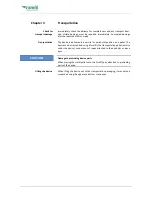
23
Maintenance
schedule
Intervals:
D
=
daily,
W
=
weekly,
M
=
monthly,
3M
=
every 3
months,
6M
=
every 6
months,
Y
=
yearly
Item
Maintenance
point
Interval
Type
of
check/maintenance
task
Comments
1
Wet
scrubber
Before
starting
cleaning
work,
drain
or
pump
out
the
content
of
the
wa
‐
ter
trap.
1.1
Air
inlet
area
W
CLEANING:
1.
Remove
deposits
of
dirt
in
the
vicinity
of
the
air
inlet
using
a
high
‐
pressure
cleaner.
Access
via
the
lower
maintenance
door
1.2
Suction
pipe/funnel
W
CLEANING:
2.
Remove
deposits
of
dirt
on
the
inside
and
outside
of
the
suc
‐
tion
pipe
and
below
the
suction
pipe
funnel.
3.
Clean
the
walls
of
the
scrubber
using
a
high
‐
pressure
cleaner.
Access
via
the
lower
maintenance
door
Separated
dust
forms
a
growing
layer
of
dirt
in
the
wet
and
dry
zones.
If
prompt
action
is
taken,
these
de
‐
posits
can
be
brushed
or
sprayed
off;
later
on
they
can
only
be
scraped
off
with
a
scraper.
1.3
Separation
zone
W
CLEANING:
4.
Remove
any
deposits
of
dirt
on
the
motor
chamber,
blade
cage,
and
walls
of
the
scrubber
with
a
high
‐
pressure
cleaner.
1.4
Motor
ventilation
lines
M
VISUAL
INSPECTION:
5.
Check
the
state
of
the
collar.
IF
NECESSARY:
1.
Replace
the
collar.
1.5
Water
return
hose
M
VISUAL
INSPECTION:
2.
Check
the
state
of
the
hose.
IF
NECESSARY:
3.
Replace
the
hose.
1.6
Water
return
pipe
(for
size
7)
M
CLEANING:
4.
Remove
any
dirt
in
the
pipe.
The
lid
must
be
removed
to
enable
cleaning.
2
Integrated
fan
2.1
Entire
fan
W
VISUAL
INSPECTION:
1.
Check
for
operating
noises;
make
sure
it
is
running
smooth
‐
ly.
IF
NECESSARY:
2.
Service
it;
rectify
faults.
2.2
Fan
impeller
W
VISUAL
INSPECTION:
3.
Completely
remove
any
depos
‐
its
of
dirt
on
the
impeller.
4.
Check
the
impeller
and
check
for
changes
(cracks,
geometric
changes,
balance,
and
wear).
Access
via
the
upper
maintenance
door
If
imbalance
is
still
present
following
impeller
cleaning,
the
impeller
must
be
rebalanced.
The
check
can
be
made
by
means
of
a
non
‐
destructive
crack
test,
for
ex
‐
ample.
An
impeller
inspection
is
required
immediately
if:
‐
The
permitted
limit
values
are
ex
‐
ceeded
‐
Changes
to
running
noise
occur
2.3
Fan
motor
W
ACOUSTIC
CHECK:
5.
Check
for
operating
noises;
make
sure
it
is
running
smooth
‐
ly.
This
check
can
only
be
made
during
ongoing
operations.
VISUAL
INSPECTION:
6.
Check
the
motor
mounting.
This
check
must
be
carried
out
when
the
system
is
at
a
standstill.
Check
this
by
shaking
the
impeller.






















